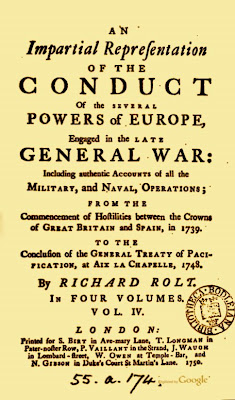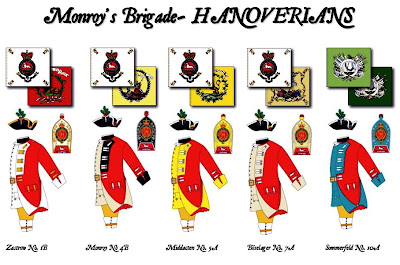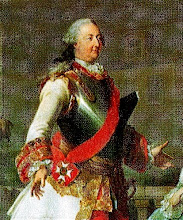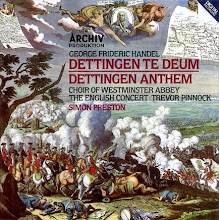Two contemporary- and quite favourable- references to the morale and performance of the Dutch army at the Battle of Roucoux in letters from a Mr. R. Leveson-Gower, to the Duke of Bedford in 1746. They were written 232 years ago almost to the day.
I searched the net for information on the Leveson-Gower family of the time. Possibly- but I'm not certain- it may have been the young Richard Leveson-Gower, born 1726, died 1753. MP for Lichfield 1747-53. He seems to have been the only member of the family whose name starts with an "R", and who was of an age to have been closely involved in the events of the time. ("I say, Holmes, how do you do it?!) Leveson-Gower appears to have been resident in The Hague at that time, but whether in any official capacity or as a private citizen I've no idea.
One can detect a certain amount of optimistic "spin" here, but the praise for the Dutch seems sincere enough. And those casualty figures are just frightful- they alone speak for some no small degree of determination. The original text can be found here.
I searched the net for information on the Leveson-Gower family of the time. Possibly- but I'm not certain- it may have been the young Richard Leveson-Gower, born 1726, died 1753. MP for Lichfield 1747-53. He seems to have been the only member of the family whose name starts with an "R", and who was of an age to have been closely involved in the events of the time. ("I say, Holmes, how do you do it?!) Leveson-Gower appears to have been resident in The Hague at that time, but whether in any official capacity or as a private citizen I've no idea.
One can detect a certain amount of optimistic "spin" here, but the praise for the Dutch seems sincere enough. And those casualty figures are just frightful- they alone speak for some no small degree of determination. The original text can be found here.
In later letters, he is less enthusiastic about the surrender by the Dutch of important border fortresses- but surrendering a fortress prematurely sounds to me more likely to be a failure of will on the part of the garrison commander rather than of his men.
******
MR. LEVESON GOWER TO THE DUKE OF BEDFORD.
Hague, October 14. 1746. N. S.
My Lord Duke,
I am extremely concerned that I am to send your Grace such bad news as that of a battle in Flanders to our great disadvantage. (Battle of Roucoux, Oct. 11th 1746)
On Tuesday 1746 last the French, as is supposed, either designing to set down before Maestricht, or to draw off the allied army from this part of the world to straiten them in their winter quarters, attacked the left of our army, composed of the troops in our pay and the Dutch, who, although they behaved with great resolution and bravery, were forced to retire behind the right wing composed of the Austrians, leaving behind them some cannon and two pair of colours.
The reason why the Austrians did not engage is, that had they gone to the assistance of the left the French would have gained their point in cutting off the communication with this country and besieging Maestricht, which they cannot do at present, as our army is now encamped under the cannon of that place. The number of the killed and wounded of our side is reckoned here from 1000 to 4000, though I send a letter from the French army to-day that said the allies left behind them but 1200. All the letters from both armies agree that the loss of the French is much more considerable, as a body of nine Hanoverian battalions defended a village against an infinite number of the enemy for four hours, which place they could not have forced but by pouring in every minute fresh supplies.
Two Bavarian regiments that arrived there but two days before are entirely ruined, as likewise two Hessian battalions, of which they say there remains but one captain and fifty private men. The Dutch behaved incomparably well, insomuch that they lost many of their officers, and some of their best regiments are almost ruined.
Of our troops I hear of but two battalions engaged, which some say are taken prisoners. Colonel Montague is said to be killed, Major Noble taken, and poor Sir Harry Nesbitt shot through the body. I have heard nothing particular of the killed and wounded of the French side. The Marquis de Fenelon, who was formerly ambassador here, is killed. I hear that Prince Waldeck, who is greatly blamed, treats this affair in his account as a thing of no great consequence.
What I here send your Grace is what I could pick up from the best hands, and what I believe you will find at present the most authentic.
On Tuesday 1746 last the French, as is supposed, either designing to set down before Maestricht, or to draw off the allied army from this part of the world to straiten them in their winter quarters, attacked the left of our army, composed of the troops in our pay and the Dutch, who, although they behaved with great resolution and bravery, were forced to retire behind the right wing composed of the Austrians, leaving behind them some cannon and two pair of colours.
The reason why the Austrians did not engage is, that had they gone to the assistance of the left the French would have gained their point in cutting off the communication with this country and besieging Maestricht, which they cannot do at present, as our army is now encamped under the cannon of that place. The number of the killed and wounded of our side is reckoned here from 1000 to 4000, though I send a letter from the French army to-day that said the allies left behind them but 1200. All the letters from both armies agree that the loss of the French is much more considerable, as a body of nine Hanoverian battalions defended a village against an infinite number of the enemy for four hours, which place they could not have forced but by pouring in every minute fresh supplies.
Two Bavarian regiments that arrived there but two days before are entirely ruined, as likewise two Hessian battalions, of which they say there remains but one captain and fifty private men. The Dutch behaved incomparably well, insomuch that they lost many of their officers, and some of their best regiments are almost ruined.
Of our troops I hear of but two battalions engaged, which some say are taken prisoners. Colonel Montague is said to be killed, Major Noble taken, and poor Sir Harry Nesbitt shot through the body. I have heard nothing particular of the killed and wounded of the French side. The Marquis de Fenelon, who was formerly ambassador here, is killed. I hear that Prince Waldeck, who is greatly blamed, treats this affair in his account as a thing of no great consequence.
What I here send your Grace is what I could pick up from the best hands, and what I believe you will find at present the most authentic.
I am, &c.
R. LEVESON GOWER
******
MR. LEVESON GOWER TO THE DUKE OF BEDFORD.
Hague, October 18. 1746. N. S.
My Lord Duke,
Your Grace will find that this affair in Flanders will not turn out so much to our disadvantage. The Dutch take it very much to heart, and the reputation their troops have got by their good behaviour makes them very uppish.
The French here, who one would imagine to be very insolent upon it, are quite the contrary : whether it proceeds from the effects they see his affair has upon the people here, or from the attack Mr. Lestock (Admiral Richard Lestock) has made upon the coasts of Britany, I can't say ; but the fact is true, and there is not one of them that says a word.
The loss of the Dutch by the muster since the action amounts to 1768 killed, wounded, and missing, and that of the troops in our pay to about the same number. The French have lost twice as many, so that they have no good reason to be very well pleased. They have since retired to their old camp at Tongres, and have begun to detach for Italy with twenty battalions and twenty squadrons.
If the King of Sardinia and the Austrians are in earnest, their detachments won't end there. Mr. Lestock (who every body supposes has done them great mischief, since they have stopt all letters) will I hope force them to detach too, and then I fancy our negotiations at Breda will have a good face, which is the sincere wish of,
R. LEVESON GOWER.The French here, who one would imagine to be very insolent upon it, are quite the contrary : whether it proceeds from the effects they see his affair has upon the people here, or from the attack Mr. Lestock (Admiral Richard Lestock) has made upon the coasts of Britany, I can't say ; but the fact is true, and there is not one of them that says a word.
The loss of the Dutch by the muster since the action amounts to 1768 killed, wounded, and missing, and that of the troops in our pay to about the same number. The French have lost twice as many, so that they have no good reason to be very well pleased. They have since retired to their old camp at Tongres, and have begun to detach for Italy with twenty battalions and twenty squadrons.
If the King of Sardinia and the Austrians are in earnest, their detachments won't end there. Mr. Lestock (who every body supposes has done them great mischief, since they have stopt all letters) will I hope force them to detach too, and then I fancy our negotiations at Breda will have a good face, which is the sincere wish of,
Looking at Leveson-Gower's first letter and his remarks on Prince Waldeck's reported reaction to the tidy drubbing that the Pragmatic Army received at Marshal de Saxe's able hands, the Prince clearly had that modern-day politician's gift for denial in the face of contradictory reality!
I also note a reference to two Bavarian regiments that formed part of the Pragmatic Army. Clearly some research is in order, as Bavarians can usually be counted upon to provide a splash of colour in any wargaming army!























